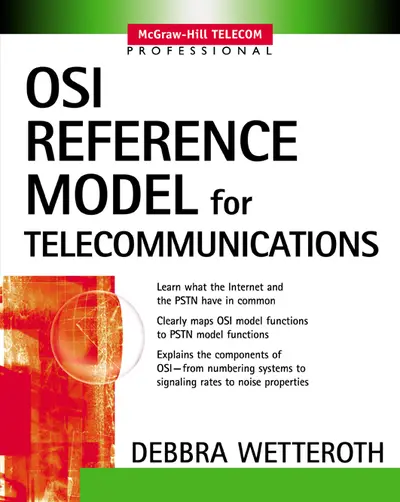My Account Details

ISBN10: 0071416056 | ISBN13: 9780071416054

Acknowledgments Chapter 1: Overview Chapter 2: Numbering Systems and Character Code Sets Chapter 3: Physical Layer (Level 1) Protocols Chapter 4: Physical Layer (Level 1) Topologies Chapter 5: Physical Layer (Level 1) Signaling Chapter 6: Data Link Layer (Level 2) Chapter 7: Network Layer (Level 3) Chapter 8: Network Layer (Level 3) Protocols Chapter 9: X.25 Protocol Networks Chapter 10: Packet-Switching Network Protocols Chapter 11: Frame Relay Chapter 12: Transport Layer (Level 4) Chapter 13: Integrated Circuits Digital Network (ISDN) Chapter 14: Asynchronous Transfer Mode (ATM) Chapter 15: Digital Subscriber Line (DSL) Chapter 16: Synchronous Optical Network (SONET) Chapter 17: Transmission Control Protocol/Internet Protocol (TCP/IP) Index
Chapter 2: Numbering Systems and Character Code Sets Chapter 3: Physical Layer (Level 1) Protocols Chapter 4: Physical Layer (Level 1) Topologies Chapter 5: Physical Layer (Level 1) Signaling Chapter 6: Data Link Layer (Level 2) Chapter 7: Network Layer (Level 3) Chapter 8: Network Layer (Level 3) Protocols Chapter 9: X.25 Protocol Networks Chapter 10: Packet-Switching Network Protocols Chapter 11: Frame Relay Chapter 12: Transport Layer (Level 4) Chapter 13: Integrated Circuits Digital Network (ISDN) Chapter 14: Asynchronous Transfer Mode (ATM) Chapter 15: Digital Subscriber Line (DSL) Chapter 16: Synchronous Optical Network (SONET) Chapter 17: Transmission Control Protocol/Internet Protocol (TCP/IP) Index
Chapter 4: Physical Layer (Level 1) Topologies Chapter 5: Physical Layer (Level 1) Signaling Chapter 6: Data Link Layer (Level 2) Chapter 7: Network Layer (Level 3) Chapter 8: Network Layer (Level 3) Protocols Chapter 9: X.25 Protocol Networks Chapter 10: Packet-Switching Network Protocols Chapter 11: Frame Relay Chapter 12: Transport Layer (Level 4) Chapter 13: Integrated Circuits Digital Network (ISDN) Chapter 14: Asynchronous Transfer Mode (ATM) Chapter 15: Digital Subscriber Line (DSL) Chapter 16: Synchronous Optical Network (SONET) Chapter 17: Transmission Control Protocol/Internet Protocol (TCP/IP) Index
Chapter 6: Data Link Layer (Level 2) Chapter 7: Network Layer (Level 3) Chapter 8: Network Layer (Level 3) Protocols Chapter 9: X.25 Protocol Networks Chapter 10: Packet-Switching Network Protocols Chapter 11: Frame Relay Chapter 12: Transport Layer (Level 4) Chapter 13: Integrated Circuits Digital Network (ISDN) Chapter 14: Asynchronous Transfer Mode (ATM) Chapter 15: Digital Subscriber Line (DSL) Chapter 16: Synchronous Optical Network (SONET) Chapter 17: Transmission Control Protocol/Internet Protocol (TCP/IP) Index
Chapter 8: Network Layer (Level 3) Protocols Chapter 9: X.25 Protocol Networks Chapter 10: Packet-Switching Network Protocols Chapter 11: Frame Relay Chapter 12: Transport Layer (Level 4) Chapter 13: Integrated Circuits Digital Network (ISDN) Chapter 14: Asynchronous Transfer Mode (ATM) Chapter 15: Digital Subscriber Line (DSL) Chapter 16: Synchronous Optical Network (SONET) Chapter 17: Transmission Control Protocol/Internet Protocol (TCP/IP) Index
Chapter 10: Packet-Switching Network Protocols Chapter 11: Frame Relay Chapter 12: Transport Layer (Level 4) Chapter 13: Integrated Circuits Digital Network (ISDN) Chapter 14: Asynchronous Transfer Mode (ATM) Chapter 15: Digital Subscriber Line (DSL) Chapter 16: Synchronous Optical Network (SONET) Chapter 17: Transmission Control Protocol/Internet Protocol (TCP/IP) Index
Chapter 12: Transport Layer (Level 4) Chapter 13: Integrated Circuits Digital Network (ISDN) Chapter 14: Asynchronous Transfer Mode (ATM) Chapter 15: Digital Subscriber Line (DSL) Chapter 16: Synchronous Optical Network (SONET) Chapter 17: Transmission Control Protocol/Internet Protocol (TCP/IP) Index
Chapter 14: Asynchronous Transfer Mode (ATM) Chapter 15: Digital Subscriber Line (DSL) Chapter 16: Synchronous Optical Network (SONET) Chapter 17: Transmission Control Protocol/Internet Protocol (TCP/IP) Index
Chapter 16: Synchronous Optical Network (SONET) Chapter 17: Transmission Control Protocol/Internet Protocol (TCP/IP) Index
Index
Need support? We're here to help - Get real-world support and resources every step of the way.